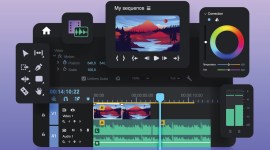
PremiumBeat vs. Storyblocks
Video content is big business. From the independent hobbyist to the professional production studio, content creators find themselves in ever-expanding ecosystems that offer everything from the latest ring light to the coolest new LUT. On the one hand, this glut of tools and assets means that content creators don’t have to look very hard for the resources they need. On the other hand, so many people selling content creators so many assets means the content world isn’t only a digital renaissance that’s democratizing video production.
There are only a few reasons why content is such big business. The first is simply its ubiquity. You can’t sell much of anything as a brand these days without compelling content. That means blogs, YouTube videos, branded content, tutorials, Instagram posts, tweets, newsletters, and on and on. If you’re a business looking to snag some attention so you can ply your wares, the number one rule is be interesting.
Another reason content is such big business is because it’s cheaper and easier to make than ever before. Professional-quality video production, in particular, was once prohibitively expensive. You needed money if you wanted your project to look better than the average weekend filmmaker with a camcorder and some clamp lights. Advances in digital technology and competition among manufacturers have brought those prices down. So, it doesn’t take much to get your hands on the same gear behind your favorite television shows. Further, many production processes are now automated within NLEs and other post-production suites, making the business of polishing a finished project just a matter of clicks. A great deal of the content up on the web now is about making content, which just goes to show you how easy it is to educate yourself and get in the game.
A third reason why content is so pervasive is that we’ve changed how we consume. We still see traditional advertisements and marketing campaigns, but they’re almost quaint now. Customers (or viewers) want experiences, and they want to relate to the brands they do business with. That means businesses have to be able to tell their stories so people can decide that they like what they see and line up for some sales.
We’ll be the first to admit that we’re part of this production ecosystem. (Big news: we have assets for sale!) We’re not trying to paint ourselves as above the market fog, but we do pride ourselves on being one of those resources that’s worth your time. There are plenty that aren’t, and they’ll take your money and leave you with an inferior product. In a world of constant content, you can’t afford an inferior anything. So, while you’re taking your time looking for best-in-class production equipment, cutting-edge applications, and top-notch talent, we’d like to talk to you about music.
The rise of royalty-free music is part of that democratizing renaissance we mentioned. Licensing professional music was also once prohibitively expensive, but not anymore. And, the fact that there are now several major players in the royalty-free music game that aren’t going anywhere, just highlights the market importance of an asset like royalty-free music. If you want your project to look good, it also has to sound good.
So, in the spirit of friendly competition, we’re taking a look at some of the other royalty free music players to see how we measure up. In this article, we’ll look at the royalty-free music libraries, the available licenses, the pricing structures, and the music quality of both PremiumBeat and Storyblocks.
1. Music Library
The most important element of any royalty-free music platform is its library. We all talk a lot of game on our blogs and in our promotional efforts, but the reality is that it all comes down to libraries. We’ll talk about the searchability of the two libraries in a little bit—after all, finding what you need within these libraries is just as important as what’s in them. But, beyond this, let’s look at the experience you can expect at each library.
We’ve been playing the royalty free music game since 2005, and we’ve learned a few things in that time, starting with be picky. We have been. There are over 20,000 songs in our music library, carefully curated over the course of 15+ years by a team of music industry professionals who hand-select the tracks we’re going to add. We never use any kind of automation, and each track gets vetted three times before it becomes a finalist for acquisition. This surgical approach means that each track we offer is professional-grade. No matter what genre or mood you need (more on that in a minute), we’ve got you covered. Each of our downloads includes full tracks, as well as shorts, loops, and stems. That means you can edit our tracks however you want, creating truly one-of-a-kind tracks that no one will hear anywhere else.
Storyblocks is a little younger, having started in 2009. But, in that time they have rapidly acquired a ton of songs and sound effects. It’s not immediately clear how many tracks they have vs. how many sound effects, but the total number of audio files is 100,000+. This is an impressive resource with a lot to offer, esp. SFX.
So, what can you expect when you land at each site? There are a few different options. At PremiumBeat, you can dive directly into the track listings. This can be a bit of a staring-into-the-sun experience, but if you know your way around music catalogs, or you’ve worked with our tracks before, this approach can make a lot of sense. If you know what you’re looking for and how to find it, you can head straight to the source, get in, and get out. Piece of cake.
But, if you prefer to take a look around and examine the decor, we have a friendlier gateway, as well. The first track listings you’ll see are our acquisition team’s hot picks. They choose each of these tracks on their own, with no oversight, and they represent our latest ideas on cutting-edge music that you might want to consider. We follow this with trending tracks, which is important if you want to cash in on what’s popular right now (or, conversely, if you want to avoid it altogether). After the trends, we offer up our latest releases, which means you can get in on some music that no one has even had a chance to hear yet. All of these approaches are based on the idea that you’re still feeling out the sound you need and not looking for something very specific (more later).
If these initial offerings don’t have what you’re listening for, we can go a little further down the rabbit hole with our moods and genres. These gateways are a great way to bring the sound of your project into alignment with a mood board. Our genre collections have something for every project, from ambient to indie pop to trip hop and beyond. We’ve got Latin jazz and Reggaeton and bluegrass. We’ve got genre genres, like Western and horror, and we even have music for kids and music from around the world. And, if that isn’t enough, there’s no shortage of moods for you to browse, like Feel Good, Sexy/Sensual, or Action/Sports.
Being picky about the songs we acquire means being picky about the artists creating them, so we hold them to a very high standard. And, once they’re on our roster, our acquisitions team works with them directly to keep developing winning tracks. You can see this talent at work in our Signature Series over at our YouTube channel (more on that later).
The library experience at PremiumBeat goes beyond sorting music into categories. We make it a point to bring you the type of high-end, one-of-a-kind collections that are worth the price. The first worth mentioning is the PRO-free collection (Performance Rights Organization). We have different licenses for different types of projects, which we’ll go over in a minute, but this particular collection is important if you’re planning on taking your project into broadcast distribution. While our premium license will cover your use of the track, many industry professionals won’t even partner with you unless you use PRO-free tracks, essentially guaranteeing that there won’t be any kind of rights trouble with the content. If you’re not heading straight to TV with your project, then don’t worry about it, but when you are ready, you’ll be glad this collection is around.
Another of our crown jewels is the Masterworks Collection. It can be difficult to find orchestral music out there, and this is often precisely what you’re looking for. The epic drone shot of the meadow in your drama doesn’t need another K-Pop song—it needs some strings. And, what orchestral music is available is available to everyone, meaning it’s been used a time or two. Our Masterworks Collection is full of live recordings of professional orchestras, so you can actually score your project.
You need to drill down into the audio section at Storyblocks (it’s a combo platform with several categories of assets to explore). Once you do, you can scroll down below the fold to see the library itself, or you can mouse over the browse link for some options like ours. There are ten moods you can explore, seven types of instrument filters, and fifteen genres to help you narrow down your search. The real strength here are the dozens of collections you can listen to. You’ll need to scroll through, as they are some specific concepts you might not be thinking of, but there are more options here.
2. Music Licensing
The real value of royalty-free music is the licensing agreement. Most platforms offer variations of similar agreements, based on their pricing structure—different tiers and uses will cost different amounts. The tl;dr version is that royalty free license agreements (the good ones) will protect you from any rights issues when you use royalty free music in your projects. In the past, music was really only available if you wrote it yourself, paid someone to write it for you, or drew up an agreement for existing songs. If you weren’t writing your own music, then you were left with finding the budget to acquire someone else’s work. As with all things filmmaking prior to the digital revolution, these budgetary constraints meant fewer projects would see the light—you needed a production company (or companies) behind your project to fund it, and they didn’t just back any old project.
Royalty-free music catalogs have changed all this. The platforms make agreements with the musicians for the rights to their songs (top-tier royalty free music libraries have exclusive agreements, so you can’t find the tracks anywhere else), and then you, the content creator, make an agreement with the platform of your choice. Royalty-free music platforms act sort of like agents in this regard, brokering an agreement between you, the creator, and the musician whose songs you want to use. However, rather than paying the musician royalties based on how much your project earns (or doesn’t—we’ll get to that), you pay either a one-time fee or a subscription rate to the platform, and the platform pays the musician.
This reduces paperwork for content creators while making sure they have all the rights they need to legally use someone else’s music. The rates you pay to a royalty free music platform like PremiumBeat or Storyblocks are substantially lower than you might pay a musician (or musicians) to score your project, and since most creators license one song at a time, musicians are free to keep cranking out songs for various projects instead of focusing on only one soundtrack for one project.
Combined with the increasing affordability of professional-grade equipment, the production power of filmmaking applications (and their affordability), and the ease of digital distribution, royalty-free music is a key element of the newer, more democratized filmmaking world. It allows you to pair professional sound with professional video and get around huge budgets and production companies. In our world of constant content, this is crucial for establishing a voice or earning a living with your content.
So, let’s take a look at the licensing models at PremiumBeat and Storyblocks. We’ll start with PremiumBeat.

Single Purchase Standard License
As we suggested above, most royalty-free music platforms have different licenses for different uses. How you intend to distribute your project and whether or not you’re going to monetize it affect the agreements that platforms make with their musicians. So, for example, it’s usually cheaper at the top-tier platforms to license a song if you don’t intend to make money off of your project (either by charging a fee to view it, or collecting advertising dollars). Further, one-time downloads can be cheaper than monthly subscription fees (although you end up paying substantially more per song this way).
All of this brings us to PremiumBeat’s Single Purchase Standard License. This is a one-time purchase for one specific track, which the agreement allows you to use in as many projects as you like in perpetuity—as long as you don’t monetize any of those projects. It’s perfect for smaller projects that don’t need several tracks—or for creators who don’t have as much available time and are therefore working on a project longer. Someone like this may prefer to parcel out production expenses one at a time when they can, rather than paying under a subscription model.
The Single Purchase Standard License is $49 USD per song, and your download includes the full track as well as shorts, loops, and stems. You can edit and customize the track however you’d like to create a truly unique soundtrack for your project. If you need to get in and out with a single song and you’re not ready for a subscription, then this license is perfect.
Monthly Subscription
Most royalty-free music libraries offer subscriptions, as they’re generally the most popular options among content creators. If you’re creating pretty steadily, you’re going to need a regular supply of music for your projects, and that’s where the subscription model comes in. Most platforms ask you for a year-long agreement when subscribing, but that doesn’t make sense to us. We know that content creation can come and go—sometimes there’s more work to do than at other times. We get that (we’re content creators, too), so our term is only for three months. That way, you can subscribe during a production period, get the tracks you need, and then unsubscribe when you’re not working. Or, if things are steady, just keep renewing that subscription. This way, we’re not hustling you out of nine months of fees you may not need.
Our monthly subscription plan, like the standard license, is for projects you don’t intend to monetize, and the agreement allows you to use the songs in as many projects as you like, for as long as you like. You get five downloads per month at a seriously reduced rate of $12.99 USD per song (rather than the single-purchase price of $49). As with the standard license, each download includes full tracks, shorts, loops, and stems, and you’re always allowed to customize however you like. With our ever-growing track list, you’re guaranteed to never browse the same library twice—there’s always fresh content for your next project.
When you’re ready to take your work to the next level and starting bringing in some earnings, you’re ready for the Premium License. This agreement allows you to earn some money from your content, either by charging for distribution or bringing in ad revenue. It also allows you to take your work to RTVF or digital broadcast, so if you’ve got a show to make or an event to put on, this license will cover all of your music needs. It’s $199 USD per track, again with full downloads, shorts, loops, and stems. Use the tracks as many times as you like on as many projects as you like—we’re about it.
Storyblocks Licensing
Storyblocks offers individual and business licensing plans. The business license is a custom arrangement based on the size of your team, meaning you’ll need to contact them for a quote. We’ll focus here on the individual plan.
Because Storyblocks offers video and SFX as well as songs, they have several different subscription plans. If you want access to all assets, it’s $30 USD per month. Unlimited video is $20 USD per month. Basic audio covers three song downloads per month at $10 USD, and unlimited SFX downloads are $15 USD per month. The models lend themselves well to high-production outfits with a little more experience in the world of rights management, as content ID claims can be an issue with the downloads. Storyblocks offers support to help resolve these claims when they arise, so it shouldn’t be a dealbreaker. But, it’s an aspect to keep in mind.
3. Music Search
Outside of the quality of the tracks themselves, a royalty-free library‘s searchability is probably the next most important element of a platform like this. Professional-quality tracks aren’t any use if you can’t find them, and the larger your library gets, the more critical accurate search functionality becomes. We’ve already discussed how you might browse the libraries at PremiumBeat and Storyblocks, but if you’re inclined to do less exploring and more direct searching, what can you expect from the two platforms?
Searching libraries this big is all about filters. Any given search term is going to yield tons of results on its own, so you have to be able to work with the site’s UX to tell it what you want to hear. The more of these filters you have, the quicker you’ll find the needle in the haystack. In fact, filters can help you narrow your search according to parameters you didn’t even know would interest you.
When you land at PremiumBeat.com, our search functionality is front and center. There’s a big, gold button, right above the fold—you can’t miss it. Click on “Start Your Search,” and we’ll guide you right into the library. From there, click the toggle to the left of the search field, and the filters will open right up. You can open each option one a time, and check all the parameters you want to apply to your search. Here’s the list of PremiumBeat’s primary search filters:
- Genre
- Mood
- Beats per minute
- Duration
- Artists
- Instruments
- Advanced (Surround, Stems, Shorts, Loops, PRO-free, Available with subscription, Instrumental-only)
At Storyblocks, you’ll need to click the dropdown next to the search field to select which medium you want. If you choose “All Audio” > “Music,” you’ll need to actually perform a search before you can begin filtering, so enter something that matches your project like “dark” or “uplifting.” From there, you can apply the following filters:
- Mood
- Genre
- Instrument
- Vocals
- Tempo
- Duration
Once you’ve spent some time searching within a library, you’ll begin to get a feel for the nuances of the collection, and your searches will get you to the tracks you want more quickly. In the beginning, don’t be afraid to experiment with different search terms while applying your filters—you never know what you might not be thinking of.
4. Music Quality
As we mentioned previously, the ecosystem of video production assets continues to grow because it’s proven itself. Content creators are continually finding newer and better tools at their fingertips. Anything that doesn’t cut it gets crushed under waves of alternatives. So, any royalty-free music library like PremiumBeat or Storyblocks that has emerged as a reliable music platform is already offering professional-quality music. If they weren’t, they’d already be done.
So, when you’re comparing two platforms like PremiumBeat and Storyblocks, you’re talking about similar calibers of music. What, then, becomes the difference between them? Issues of licensing, searchability, and customization aside, you’re trying to determine which offering deserves the label “best in class.” We can’t speak to the action behind-the-scenes at Storyblocks, but we can position our offering by telling you a little about how we curate it.
Our acquisitions team comes straight from the music industry—we recruited them directly onto our team to oversee our library from the beginning. These professionals hand-vet each track three times—we don’t rely on any algorithms or automation. If a track meets our high quality standards and clears three vettings, then it’s primed to join the library. Once we have the shorts, loops, and stems for the track ready, we take the time to prepare the metadata about the song so you’ll be able to find it. That’s what all the discussion in this article has really been about—handling each track down to the most minute detail before it hits our digital shelves.
Beyond this sort of white-glove inspection, we also aim to make music available to you that you wouldn’t think to consider—making the job of scoring your project easier and more interesting. With tracks from around the globe, our world music genre includes work from twenty different countries. That’s twenty different cultures with new ideas about what’s trending and why, meaning you can make your project truly globally aware.
5. Industry Expertise
Building a successful royalty free music library full of professional-grade tracks that content creators actually want to use is one thing—keeping it going is another thing altogether. Any library that simply focuses on being bigger will eventually begin to miss the point. These libraries are full of assets that creators need to keep rising above all the noise. They need to grow and adapt because needs and trends will change. The old adage “adapt or die” is so true.
To offer truly helpful assets for content creators, you have to actually know what they need. And, that means being in the game yourself. At PremiumBeat, we’re also content creators. You can click through to our popular blog, The Beat, where we’ve been putting out dozens of articles, interviews, product reviews, round tables, tutorials, and case studies every month—for years. If it has to do with filmmaking, we’ve covered it—industry news, gear, cinematography techniques, color correction, industry trends, you name it. We know what it is to create content, and we know how difficult it can be to find the assets you need when you need them (that’s why we’re always giving some away).
But, we’re not only talking about articles. We put out videos on our YouTube channel on all things filmmaking—how-tos, reviews, tutorials, walk-throughs. If there’s something you want to learn how to do, we’ve done it. And, you’ll see that we use our music in everything we do—click through to the meta descriptions and you’ll find everything you need to know about which songs we chose for each video. And, not only do we use PremiumBeat tracks on the PremiumBeat channel, we use them in our work, as well, because we believe in what we’ve curated.
We’d be lying if we didn’t say that we think our royalty-free music library is the best out there. We know we have some competition, and there are some great platforms you can also consider. When you take all of these criteria together, we believe that PremiumBeat offers the most comprehensive, best-in-class experience you’re looking for. But, don’t take our word for it. Hit the library and listen to some music yourself. We’ll bet you find a thing or two you could use . . .





